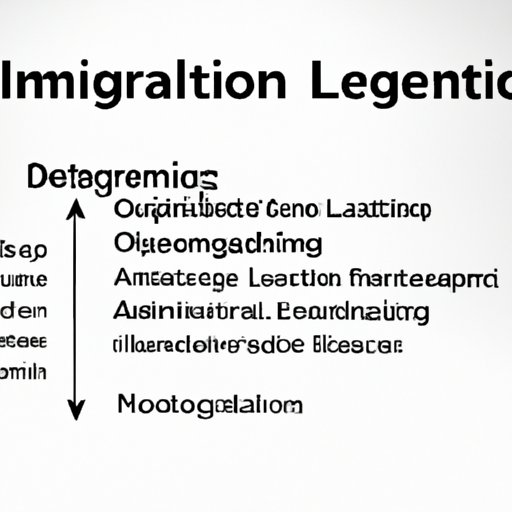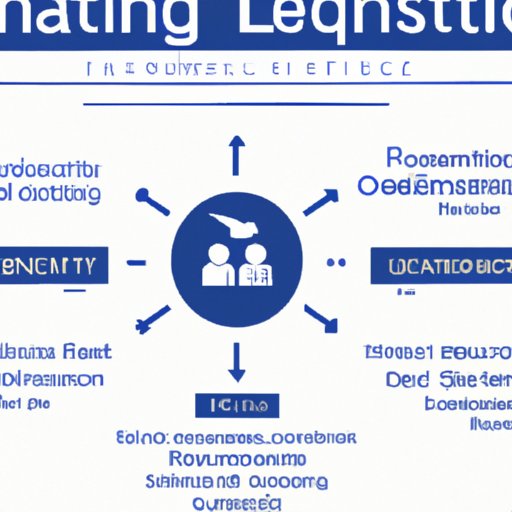Introduction
Organizational leadership is a complex and multi-faceted concept that is essential for any business or organization to succeed. It involves the process of influencing and motivating a group of individuals in order to achieve a common goal. Effective leaders must have a clear vision, be able to make decisions, communicate effectively, collaborate with others, resolve conflicts, motivate their team, solve problems, and inspire others. In this article, we will explore the qualities and responsibilities of organizational leadership, best practices for crafting an effective leadership style, and strategies for creating and sustaining a high-performing team.

Defining Organizational Leadership: A Look at the Essential Qualities and Responsibilities
What are the essential qualities and responsibilities of an effective leader? According to Harvard Business Review, “Effective leadership combines the right skills, behaviors, and attitudes to create a compelling vision, establish trust, and motivate people to take action.”
Vision
The first and most important quality of an effective leader is the ability to create and articulate a clear vision. This means having a deep understanding of the organization’s goals and objectives and being able to communicate them in a way that inspires and motivates others.
Decision Making
Leaders must also be able to make decisions quickly and confidently. They must be able to weigh the pros and cons of various options and come to a conclusion that is in the best interest of the organization.
Communication
Effective communication is essential for any leader. Leaders must be able to clearly express their ideas and visions to their team and ensure they are understood. They must also be open to feedback and willing to listen to different perspectives.
Collaboration
Leaders must also be able to work collaboratively with others. This means being able to build relationships, foster collaboration, and delegate tasks appropriately.
Conflict Resolution
Leaders must also be able to identify and manage conflicts within the organization. This requires the ability to recognize potential sources of conflict, understand different perspectives, and facilitate a resolution that is beneficial for all involved.
Motivation
Leaders must be able to motivate and inspire their team to reach their goals. This involves recognizing individual strengths and weaknesses, providing support and guidance, and recognizing and rewarding accomplishments.
Problem Solving
Leaders must also be able to identify and address problems quickly and efficiently. This includes being able to analyze data, identify root causes, and develop solutions that are both practical and effective.
Inspiration
Finally, effective leaders must be able to inspire and energize others. This means being passionate about the organization’s mission and purpose and having the ability to ignite enthusiasm in others.

Crafting an Effective Organizational Leadership Style: Exploring Best Practices
Developing an effective organizational leadership style requires an understanding of the essential qualities and responsibilities of a leader, as well as best practices for crafting an effective leadership style.
Developing Your Personal Leadership Style
The first step in developing an effective organizational leadership style is to assess your own strengths and weaknesses. This means taking the time to reflect on your current leadership style, understanding your own strengths and weaknesses, and identifying areas where you could improve.
Understanding Your Team Members
The next step is to gain a better understanding of your team members. This includes getting to know each individual’s strengths and weaknesses, learning about their personal goals and motivations, and understanding how they prefer to be managed.
Setting Clear Goals and Expectations
Once you have a better understanding of your team members, it is important to set clear goals and expectations. This means establishing realistic timelines, outlining specific roles and responsibilities, and providing adequate resources to ensure success.
Establishing a Culture of Respect and Trust
It is also important to establish a culture of respect and trust among team members. This means ensuring everyone is treated fairly, listening to different perspectives, and providing support and encouragement.
Modeling Positive Behaviors
Finally, effective leaders must be willing to model positive behaviors. This means leading by example and demonstrating the same values and behaviors that they expect from their team members.
The Role of Organizational Leadership in Creating and Sustaining a High-Performing Team
Creating and sustaining a high-performing team is one of the most important responsibilities of any leader. This requires recruiting and retaining talented individuals, setting clear roles and responsibilities, establishing strong relationships, encouraging creative thinking, and promoting a culture of collaboration.
Building a High-Performing Team
The first step in building a high-performing team is to recruit and retain talent. This means identifying key positions and screening candidates to ensure they have the necessary experience and qualifications. Once the team is in place, it is important to set clear roles and responsibilities and ensure everyone understands their part in achieving the organization’s goals.
Establishing Strong Relationships
The next step is to establish strong relationships between team members. This means fostering an environment of trust and mutual respect and encouraging open communication. It also means providing opportunities for team members to collaborate and learn from each other.
Encouraging Creative Thinking
Leaders must also be willing to encourage creative thinking and risk-taking. This means providing the necessary resources and support to enable team members to experiment and innovate.
Promoting a Culture of Collaboration
Finally, leaders must promote a culture of collaboration. This means valuing diversity and different perspectives and creating an environment where everyone feels safe to contribute their ideas.
Developing an Effective Organizational Leadership Strategy: A Step by Step Guide
In order to create and sustain a high-performing team, it is important to develop an effective organizational leadership strategy. This involves analyzing your current leadership strategy, identifying key areas for improvement, setting clear goals and objectives, developing strategies to achieve those goals, and implementing and measuring progress.
Developing an Effective Organization Leadership Strategy
The first step is to analyze your current leadership strategy. This involves reflecting on your current approach and assessing its effectiveness. It is also important to identify areas where you could improve, such as communication, decision making, collaboration, or problem solving.
Identifying Key Areas for Improvement
Once you have identified areas for improvement, it is important to set clear goals and objectives. This means focusing on specific skills or behaviors that you want to develop and outlining steps you can take to achieve those goals.
Setting Clear Goals and Objectives
The next step is to develop strategies to achieve those goals. This might include attending workshops or seminars, reading books, or participating in mentorship programs. It is also important to identify resources that can help you reach your goals, such as mentors or coaches.
Developing Strategies to Achieve Goals
Once you have developed strategies to achieve your goals, it is important to implement them. This involves putting the strategies into practice, monitoring progress, and making adjustments where necessary.
Implementing Strategies and Measuring Progress
Finally, it is important to measure progress and ensure that your strategies are working. This means regularly assessing your performance and making changes to increase efficiency and effectiveness.

Understanding Organizational Leadership: Examining Different Types of Leaders and Their Roles
Organizational leadership is a complex concept and there are many different types of leaders. Some of the most common types of leaders include transformational leaders, charismatic leaders, democratic leaders, and autocratic leaders. Each type of leader has a different style and approach, and it is important to understand the role they play in creating and sustaining a high-performing team.
Different Types of Leaders
Transformational leaders are focused on inspiring and motivating their team. They have a clear vision and strive to create an environment that encourages creativity and innovation. Charismatic leaders are focused on building relationships and inspiring loyalty. They are typically highly visible and often lead through example. Democratic leaders emphasize collaboration and encourage participation. They focus on creating an environment where everyone feels heard and respected. Autocratic leaders emphasize structure and control. They focus on setting clear expectations and enforcing rules and regulations.
Conclusion
Organizational leadership is an essential component of any successful business or organization. Effective leaders must have a clear vision, be able to make decisions, communicate effectively, collaborate with others, resolve conflicts, motivate their team, solve problems, and inspire others. Crafting an effective leadership style requires an understanding of the essential qualities and responsibilities of a leader, as well as best practices for creating and sustaining a high-performing team. Developing an effective organizational leadership strategy involves analyzing your current leadership strategy, identifying key areas for improvement, setting clear goals and objectives, developing strategies to achieve those goals, and measuring progress. Finally, it is important to understand the different types of leaders and their roles in creating and sustaining a high-performing team.
Organizational leadership plays a critical role in the success of any business or organization. Leaders must have a clear vision, be able to make decisions, communicate effectively, collaborate with others, resolve conflicts, motivate their team, solve problems, and inspire others. By understanding the essential qualities and responsibilities of a leader, crafting an effective leadership style, and developing an effective organizational leadership strategy, leaders can create and sustain a high-performing team that is capable of achieving great things.
(Note: Is this article not meeting your expectations? Do you have knowledge or insights to share? Unlock new opportunities and expand your reach by joining our authors team. Click Registration to join us and share your expertise with our readers.)
